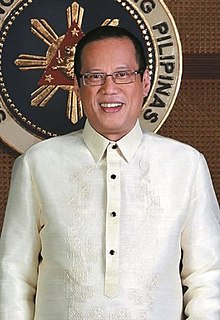 | |
| Presidency of Benigno Aquino III June 30, 2010 – June 30, 2016 | |
Benigno S. Aquino III | |
| Cabinet | See list |
| Party | Liberal |
| Election | 2010 |
| Seat | Malacañang Palace, Manila |
|
| |
| ||
|---|---|---|
Foreign policy Early political career
Life and politics
|
||
Benigno Aquino III began his presidency at noon on June 30, 2010, following his inauguration as the 15th president of the Philippines, succeeding Gloria Macapagal Arroyo. Aquino, the third-youngest person elected president,[1] is the only son of the 11th president, Corazon Aquino, and former senator Benigno Aquino Jr.
Aquino continued the process of implementing the K–12 curriculum in the country that started when the Omnibus Education Reform Act of 2008 (Senate Bill 2294) was filed on May 20, 2008 during the presidency of his predecessor Gloria Macapagal Arroyo. He enacted the Reproductive Health Bill, providing universal access to methods on contraception. He launched the public-private partnership program to hasten infrastructure development,[2] and formed a commission to investigate issues and corruption allegations against his predecessor, President Gloria Macapagal-Arroyo.
Aquino extended the modernization program of the military for 15 years. He signed the Enhanced Defense Cooperation Agreement, allowing the United States's military to rotate troops into the Philippines for extended stays and authorizing the US to build and operate facilities on Philippine bases.
Aquino oversaw the Manila hostage crisis, the impeachment of Chief Justice Renato Corona, the Typhoon Yolanda government response, the Zamboanga City crisis, and the Mamasapano clash.
- ^ Quezon III, Manuel (June 19, 2010). "Trivia on Aquino and Binay". ABS-CBN News. Archived from the original on June 23, 2015. Retrieved September 20, 2020.
- ^ Remitio, Rex (February 11, 2016). "Two more PPP projects expected to be finished before Aquino's term ends". CNN Philippines. Archived from the original on February 13, 2016. Retrieved May 28, 2022.



